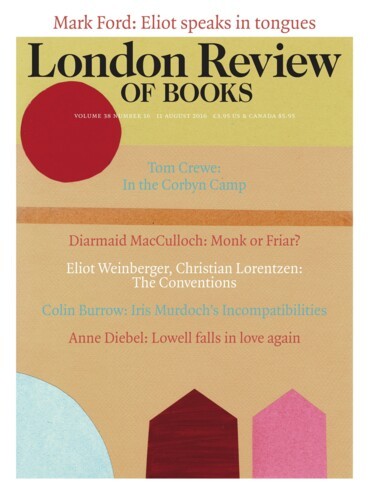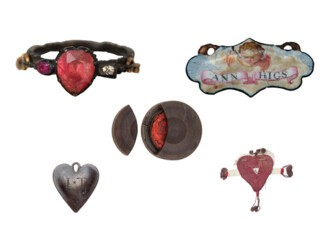The Foundling Hospital was established in Bloomsbury in 1739 by the philanthropist Thomas Coram, ‘for the education and maintenance of exposed and deserted young children’. Strictly speaking, they weren’t foundlings: the parents, or more usually the mother, had to hand over their offspring and were instructed to ‘affix on each child some particular writing, or other distinguishing mark or token, so that the child may be known thereafter if necessary’. By 1790, 18,000 of these objects had been collected; women had continued to leave them for decades after they were replaced by paper receipts in 1760. The Victorians exhibited some of the old tokens, and accidentally separated them from the names of the corresponding children. When the hospital moved to Surrey in 1926 the original building was demolished, although some of its interiors survive in the present Foundling Museum on Brunswick Square, along with many of the tokens. They include coins, buttons, a hazelnut, a tiny rouge pot, many heart-shaped mementos and at least one plain metal disc inscribed ‘this is a token.’
The hospital was in a sense Britain’s first public art gallery. William Hogarth was among the founders: he fostered children, designed their uniforms and a coat of arms for the hospital, and solicited donations of work from other artists. The museum contains paintings by Reynolds and Gainsborough as well as Hogarth himself. Artistic connections remain: every two years an artist, a writer and a musician are invited to create projects. The result of Cornelia Parker’s fellowship is Found (until 4 September), for which, in the spirit of Hogarth’s improving curatorial impulse, she asked almost seventy people, mostly visual artists, to submit objects or works. The distinction between the categories of found articles and finished artworks is always uncertain in this suggestive and sometimes frustrating show.
Parker is well practised in the redeployment of found objects; her work has long been concerned with the eloquence of ordinary things. She is best known for spatially dominating sculptural installations like Breathless – a suspended circle of brass musical instruments, all steamrollered flat – and Cold Dark Matter: An Exploded View, fragments of a wooden shed, hung in the gallery as though mid-explosion. Much of her work, however, has concerned smaller, discreet things, their transformation and potential. The Maybe, an installation at the Serpentine Gallery in 1995, is remembered chiefly for Tilda Swinton sleeping in a vitrine, but it included, also under glass, a pair of Queen Victoria’s stockings, Turner’s watercolour set and a blanket that belonged to Freud (in Marks Made by Freud, Subconsciously, Parker photographed creases in the leather of the analyst’s chair). In 1992 she threw a silver Georgian teapot off the southern edge of England, and preserved the battered vessel and its chalk smudges as Object that Fell off the White Cliffs of Dover.
Found consists of a slightly crowded exhibition in the museum’s modest ground-floor gallery, as well as numerous pieces dispersed elsewhere in the building, among historical artworks and displays about the history of the hospital. Parker establishes early on just how many things may be meant by the phrase ‘found object’. There are items picked up from the street, such as Graeme Miller’s grid of playing cards from cities around the world, and Jarvis Cocker’s collection of Romania Today magazines from the 1970s. There are images found on the internet: Mark Wallinger’s The Unconscious is a series of photographs of people who have fallen asleep on public transport. Most of the artists have responded to Parker’s request with a seriousness that can occasionally verge on preciousness. Few are funny, among them Laure Prouvost’s short video Stong Sory Vegetables, in which a faceless narrator points offscreen at fruit and vegetables set on a plinth in the gallery, and claims they fell out of the sky and landed on her bed.
The best things in Found are the least keen to ape the melancholy of the museum’s collection of tokens, or to invoke too easily the spectres of lost children and absent parents. Tacita Dean’s Found Fortress is a foot-wide piece of black and white embroidery, bought at a flea market in France, that shows a medieval, or mock-medieval, crenellated structure, with a tiny figure on horseback in the foreground. Dean has reversed the fragment so that it looks like a photographic negative, the scene resembling the darkling approach to the vampire’s castle in Nosferatu. The artist-filmmaker John Smith exhibits a short stick that his father used over several decades to stir paint; its end has been sawn off to reveal thirty or so concentric rings of dried paint, going all the way back to the grey-green of 1950s kitchen cabinets. This would be a straightforward memorial fragment, were it not for the accompanying video in which Smith recalls being beaten by his father – ‘though he hated doing it’.
Others show work in which the found object has been through a process of ageing, accretion or translation. Phyllida Barlow’s Untitled: Molotov 2015, a colourful agglomeration of wood, plastic, fabric, plaster and more, is a coffee-table-height version of her more expansive sculptures. Rachel Whiteread’s small bronze Untitled (Found Heel and Toes) was cast from a decayed shoe dug up while she was making a large public work on Governors Island, off Manhattan. And 25 metres down in Killary Fjord in the west of Ireland, Dorothy Cross discovered her Tube Worm Bottle, its milky glass half covered in hard white protuberances, a forest of bony new life.
Some contributions cut straight to the motif of lost and found children, or tell family stories too delicately borne by inherited artefacts. Antony Gormley’s small round black Iron Baby, face down in an empty room, feels practically tautological. Most of the writers invited to take part have contributed heirlooms or gewgaws – Justine Picardie’s moonstone engagement ring is pretty, but not really resonant – and of these only Marina Warner’s sperm-whale tooth, discovered among her mother’s belongings, comes with much historical or cultural freight.
Among Parker’s own contributions is an installation called There Must Be Some Kind of Way out of Here, made from the staircase in Jimi Hendrix’s London flat. Steps and panels and doorway are laid out at the bottom of the museum’s main stairs. On the wall nearby is Patrick Caulfield’s 1968 screenprint Found Objects. On a plain mauve ground, a feeble collection of archaeological finds is set out: a couple of potsherds, half a dozen pebbles, a few twigs and two white dots that might be lumps of chalk. The picture is a laconic reminder that one collector’s treasure is another’s trash, that a deadpan readymade may trump self-conscious curiosities.
Send Letters To:
The Editor
London Review of Books,
28 Little Russell Street
London, WC1A 2HN
letters@lrb.co.uk
Please include name, address, and a telephone number.


